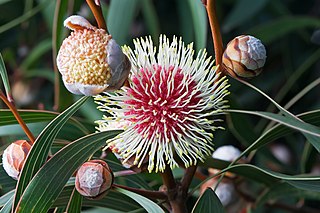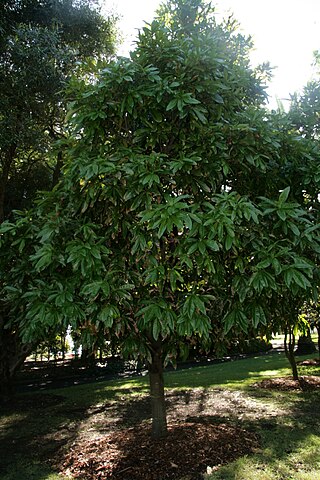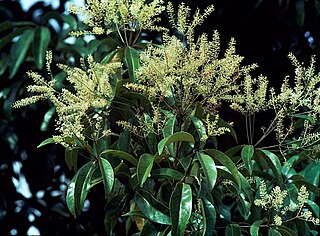Mount Bauple is a scientific national park in the Fraser Coast Region, Queensland, Australia, 190 km north of Brisbane.

In botany, a nut is a fruit from a tree consisting of a hard or tough nutshell protecting a kernel which is usually edible. The shell is indehiscent, meaning it does not open to release the seed. Most seeds come from fruits that naturally free themselves from the shell, but this is not the case in nuts such as hazelnuts, chestnuts, and acorns, which have hard shell walls and originate from a compound ovary.

Hicksbeachia is a genus of two species of trees in the family Proteaceae. They are native to rainforests of northern New South Wales and southeastern Queensland, Australia. They are commonly known as red bopple nut or beef nut due to the bright red colour of their fruits.

Macadamia oil, also known as macadamia nut oil, is a non-volatile oil extracted from the nuts of the macadamia tree, indigenous to Australia. This oil is used in culinary applications as a frying or salad oil, and in cosmetics for its emollient properties and as a fragrance fixative.

The Proteaceae form a family of flowering plants predominantly distributed in the Southern Hemisphere. The family comprises 83 genera with about 1,660 known species. Australia and South Africa have the greatest concentrations of diversity. Together with the Platanaceae, Nelumbonaceae and in the recent APG IV system the Sabiaceae, they make up the order Proteales. Well-known Proteaceae genera include Protea, Banksia, Embothrium, Grevillea, Hakea, and Macadamia. Species such as the New South Wales waratah, king protea, and various species of Banksia, Grevillea, and Leucadendron are popular cut flowers. The nuts of Macadamia integrifolia are widely grown commercially and consumed, as are those of Gevuina avellana on a smaller scale.

The Grevilleoideae are a subfamily of the plant family Proteaceae. Mainly restricted to the Southern Hemisphere, it contains around 46 genera and about 950 species. Genera include Banksia, Grevillea, and Macadamia.

Kermadecia is a genus of flowering plants in the family Proteaceae. The genus comprises eight species of rainforest trees from New Caledonia, Fiji, and Vanuatu. Its closest relative is Euplassa from South America.

Macadamia tetraphylla is a tree species in the family Proteaceae native to Australia. Common names include macadamia nut, bauple nut, prickly macadamia, Queensland nut, rough-shelled bush nut and rough-shelled Queensland nut.

Eidothea hardeniana, commonly named nightcap oak, is a species of tree, up to 40 m (130 ft) tall, of the plant family Proteaceae, which botanist Robert Kooyman recognised as a new species only recently in 2002. It is found only in the Nightcap Range in northern New South Wales, Australia. The species has an official listing as critically endangered on the Australian Commonwealth EPBC Act and as Endangered on the NSW Threatened Species Act. The name hardeniana honours the botanist Gwen Harden. Phylogenetics studies now suggest it represents a basal branch of the Proteoid clade of the Proteaceae.

Hicksbeachia pinnatifolia is a small tree in the family Proteaceae. Common names include red bopple nut, monkey nut, red nut, beef nut, rose nut and ivory silky oak.

Virotia is a genus of six species of flowering plants in the family Proteaceae. The genus is endemic to New Caledonia with six species that were once placed in Macadamia. Its closest relatives are the Australian Athertonia and the Asian Heliciopsis. The genus is named after Robert Virot, pioneer of ecological studies in New Caledonia and author of a monograph of New Caledonian Proteaceae.

Nothorites is a monotypic genus in the macadamia family Proteaceae. The sole species, Nothorites megacarpus, is endemic to the wet tropics rain forests of northeastern Queensland, Australia.

Lasjia is a genus of six species of trees of the family Proteaceae. Three species grow naturally in northeastern Queensland, Australia and three species in Sulawesi, Indonesia. Descriptively they are the tropical or northern macadamia trees group. Lasjia species characteristically branched compound inflorescences differentiate them from the Macadamia species, of Australia, which have characteristically unbranched compound inflorescences and only grow naturally about 1,000 km (620 mi) further to the south, in southern and central eastern Queensland and in northeastern New South Wales.

The H2 Hinde Tree is a heritage-listed tree of the species Macadamia integrifolia at Colliston, 926 Gilston Road, Gilston, City of Gold Coast, Queensland, Australia. It was added to the Queensland Heritage Register on 14 August 2008.

Macadamia jansenii is an endangered and poisonous tree in the flowering plant family Proteaceae, native to Queensland in Australia. It was only described as a new species in 1991, being first brought to the attention of plant scientists in 1983 by Ray Jansen, a sugarcane farmer and amateur botanist from South Kolan in Central Queensland. Closely related to the cultivated and recently domesticated macadamia nut, it has small 11–16 mm diameter nuts that have a smooth, hard, brown shell enclosing a cream, globulose kernel that is bitter and inedible. In the wild it grows as a multi-stemmed 6–9m tall evergreen tree, with leaves having entire margins and generally in whorls of 3. An extremely rare species, it was discovered as a single population of around 60 plants in the wild in Eastern Australia. In 2018 about 60 new mature Macadamia jansenii trees were located, although a quarter of these were destroyed in the bush fires of 2019.

Lasjia grandis, also known as the satin silky oak or Barong nut, is a species of forest tree in the protea family that is endemic to north-eastern Queensland, Australia. Its conservation status is considered to be Vulnerable under Queensland's Nature Conservation Act 1992.

Lasjia whelanii, also known as Whelan's silky oak, Whelan's nut oak or Whelan's macadamia, is a species of large forest tree in the protea family that is endemic to north-eastern Queensland, Australia.
Lasjia hildebrandii, also known as Celebes nut, Sulawesi nut, Sulawesi macadamia or Hildebrand's macadamia, is a species of forest tree in the protea family that is endemic to the island of Sulawesi, Indonesia. Its closest relative is Lasjia erecta, also a Sulawesi endemic.

























